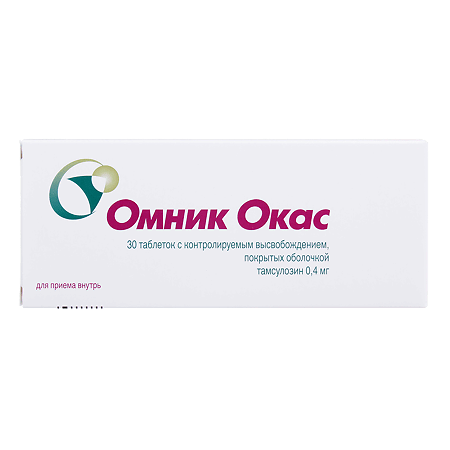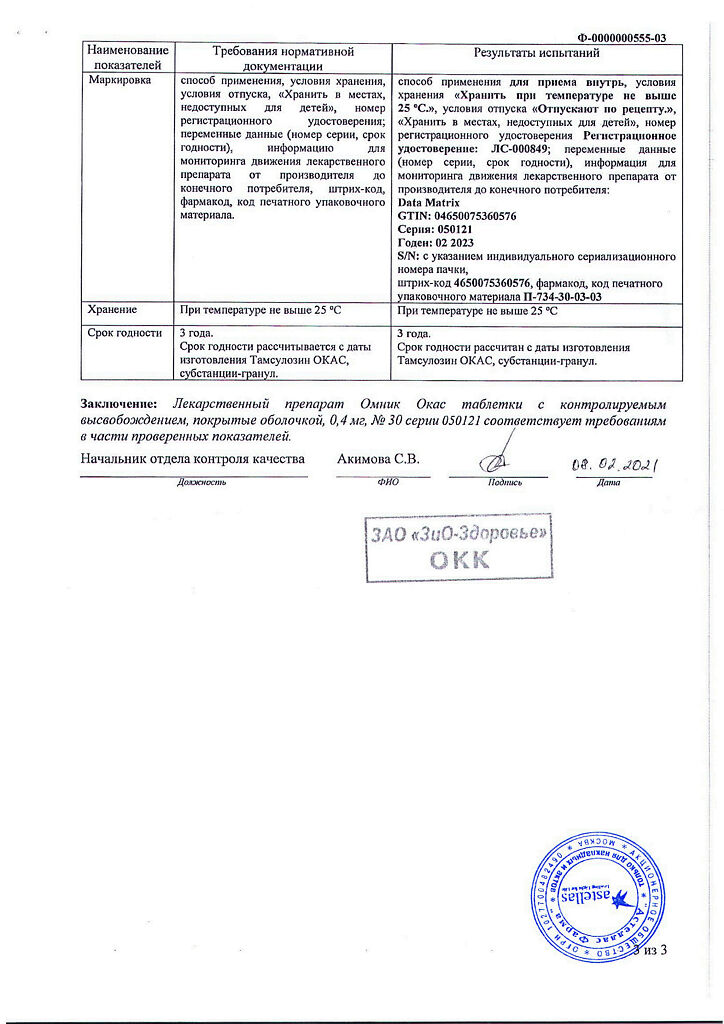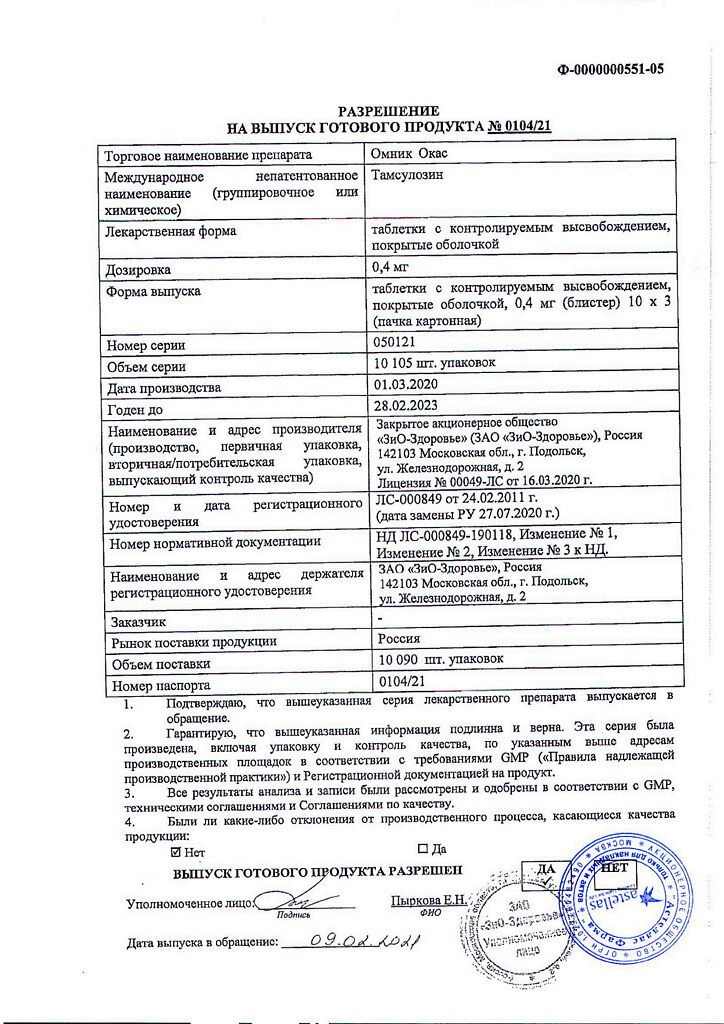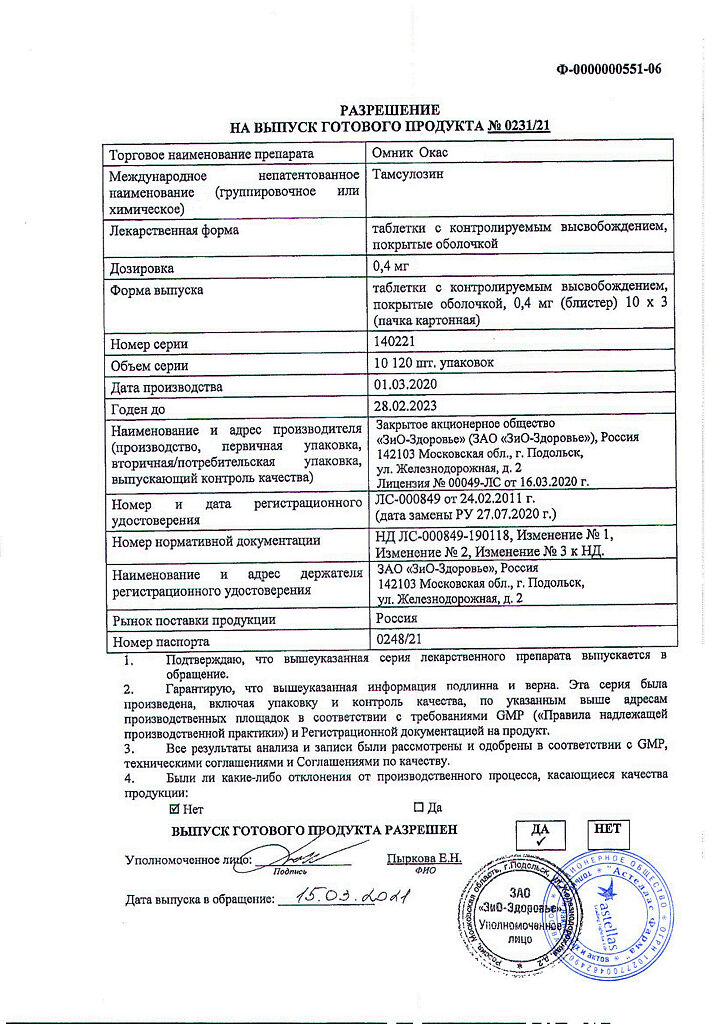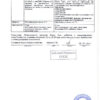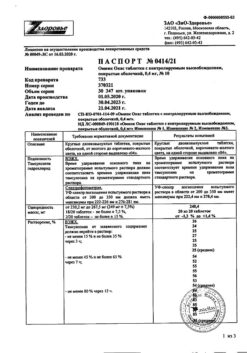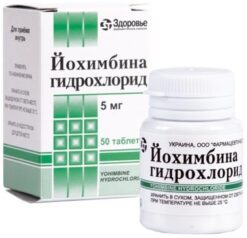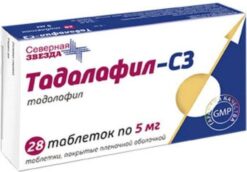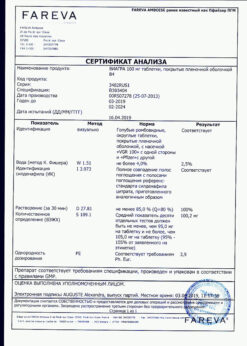No products in the cart.
Omnic Ocas, 0.4 mg 30 pcs
€20.68 €17.23
Description
Omnik Okas is an antidisuric, alpha-adrenolytic.
Pharmacodynamics
Tamsulosin is a specific competitive blocker of postsynaptic α1-adrenoreceptors, especially subtypes α1A and α1D, responsible for relaxing the smooth muscle of the prostate, bladder neck and prostatic urethra.
Omnik Okas in a dosage of 0.4 mg increases the maximum rate of urination and also reduces the tone of the smooth muscles of the prostate and urethra, improving the flow of urine and thus reducing the severity of symptoms of emptying. Omnic Okas also reduces the severity of symptoms of filling, in the development of which detrusor hyperactivity plays an important role.
In long-term therapy, the effect on the severity of filling and voiding symptoms is maintained, reducing the risk of acute urinary retention and the need for surgical intervention.
The α1A-adrenoreceptor blockers may decrease BP by reducing peripheral resistance. No clinically significant decrease in BP has been observed with the use of Omnic Okas at a daily dose of 0.4 mg.
Pharmacokinetics
Intake. Omnic Okas is a matrix-based controlled-release tablet using a nonionic gel. This dosage form provides prolonged and slow release of tamsulosin and sufficient exposure with little variation in plasma tamsulosin concentrations over 24 hours.
Tamsulosin in the form of Omnic Okas tablets is absorbed in the intestine. Absorption is estimated at 57% of the administered dose. Food intake has no effect on the absorption of the drug. Tamsulosin is characterized by linear pharmacokinetics. After a single oral intake of Omnic Okas tablet on an empty stomach, the Cmax of tamsulosin in plasma is reached after 6 hours on average. In the equilibrium state, which is reached by the 4th day of use, the plasma concentration of tamsulosin reaches its highest value after 4-6 hours both on an empty stomach and after a meal. Plasma Cmax increases from approximately 6 ng/ml after the first dose to 11 ng/ml at equilibrium. The lowest plasma concentration of tamsulosin is 40% of the maximum plasma concentration on an empty stomach and after meals. There are significant individual differences among patients with respect to plasma concentrations of the drug after a single dose and multiple doses.
Distribution. Binding to plasma proteins is about 99%, Vd is small (about 0.2 l/kg).
Metabolism. Tamsulosin is slowly metabolized in the liver to form less active metabolites. Most of tamsulosin is present in blood plasma in unchanged form. The ability of tamsulosin to induce activity of microsomal liver enzymes is almost absent (experimental data).
In case of hepatic insufficiency no dosing regimen adjustment is required.
Extractions. Tamsulosin and its metabolites are primarily excreted in the urine, with approximately 4-6% of the drug excreted unchanged.
The T1/2 of tamsulosin in the form of Omnic Okas tablets on single administration and in equilibrium is 19 and 15 h, respectively.
Indications
Indications
Benign prostatic hyperplasia (treatment of urinary disorders).
Pharmacological effect
Pharmacological effect
Omnic Okas – antidysuric, alpha-adrenolytic.
Pharmacodynamics
Tamsulosin is a specific competitive blocker of postsynaptic α1-adrenergic receptors, especially the α1A and α1D subtypes, which are responsible for relaxing the smooth muscles of the prostate gland, bladder neck and prostatic urethra.
Omnic Okas at a dosage of 0.4 mg increases the maximum speed of urination, and also reduces the tone of the smooth muscles of the prostate gland and urethra, improving the outflow of urine, etc. reducing the severity of bowel movements. Omnic Okas also reduces the severity of filling symptoms, in the development of which detrusor overactivity plays an important role.
With long-term therapy, the effect on the severity of filling and emptying symptoms is maintained, reducing the risk of developing acute urinary retention and the need for surgical intervention.
α1A-adrenergic blockers may lower blood pressure by reducing peripheral resistance. When using the drug Omnic Okas in a daily dose of 0.4 mg, no cases of clinically significant decrease in blood pressure were observed.
Pharmacokinetics
Suction. Omnic Ocas is a matrix-based controlled release tablet using a non-ionic gel. This dosage form provides a long and slow release of tamsulosin and sufficient exposure with slight fluctuations in tamsulosin plasma concentrations over 24 hours.
Tamsulosin in the form of Omnic Okas tablets is absorbed in the intestines. Absorption is estimated at 57% of the administered dose. Eating does not affect the absorption of the drug. Tamsulosin is characterized by linear pharmacokinetics. After a single oral administration of Omnic Ocas tablets on an empty stomach, the Cmax of tamsulosin in plasma is achieved on average after 6 hours. In an equilibrium state, which is achieved by the 4th day of administration, the concentration of tamsulosin in plasma reaches its highest value after 4-6 hours both on an empty stomach and after a meal. Cmax in plasma increases from approximately 6 ng/ml after the first dose to 11 ng/ml at steady state. The lowest plasma concentration of tamsulosin is 40% of the maximum fasting and postprandial plasma concentration. There is significant individual variation among patients in plasma concentrations of the drug after a single dose and multiple doses.
Distribution. Plasma protein binding is about 99%, Vd is small (about 0.2 l/kg).
Metabolism. Tamsulosin is slowly metabolized in the liver to form less active metabolites. Most of tamsulosin is present in the blood plasma in unchanged form. The ability of tamsulosin to induce the activity of microsomal liver enzymes is practically absent (experimental data).
In case of liver failure, no dosage adjustment is required.
Excretion. Tamsulosin and its metabolites are primarily excreted in the urine, with approximately 4–6% of the drug excreted unchanged.
T1/2 of tamsulosin in the form of Omnic Okas tablets with a single dose and at steady state is 19 and 15 hours, respectively.
Special instructions
Special instructions
During surgical interventions for cataracts while taking the drug, the development of intraoperative instability syndrome of the iris (narrow pupil syndrome) is possible, which must be taken into account by the surgeon for preoperative preparation of the patient and during the operation.
Before starting therapy with Omnic Ocas, the patient should be examined to exclude the presence of other diseases that can cause the same symptoms as benign prostatic hyperplasia. Before starting treatment and regularly during therapy, a digital rectal examination and, if required, determination of a specific prostate antigen should be performed.
In case of renal failure, no dose change is required.
Impact on the ability to drive vehicles and machinery
There is no data on the negative impact on the ability to drive vehicles and engage in potentially hazardous activities. However, due to the possibility of dizziness, until the patient’s individual reaction is clarified, you should refrain from activities that require increased concentration and speed of psychomotor reactions, incl. from driving vehicles.
Active ingredient
Active ingredient
Tamsulosin
Composition
Composition
Active ingredient:
tamsulosin hydrochloride 0.4 mg;
Excipients:
macrogol 8000 – 40 mg;
macrogol 7000000 – 200 mg;
magnesium stearate – 1.2 mg;
Shell:
Opadry yellow 03F22733 (hypromellose – 69.536%, macrogol 8000 – 13.024%, iron oxide yellow dye – 17.44%)
Contraindications
Contraindications
hypersensitivity to tamsulosin or any other component of the drug;
orthostatic hypotension;
severe liver failure.
With caution – chronic renal failure (Cl creatinine
Side Effects
Side Effects
Rarely – dizziness, retrograde ejaculation; in isolated cases – orthostatic hypotension, tachycardia/palpitations, asthenia, headache.
From the gastrointestinal tract: rarely – nausea, vomiting, diarrhea, constipation.
In extremely rare cases, hypersensitivity reactions (skin rash, itching, angioedema) may occur.
Interaction
Interaction
No interactions were observed when tamsulosin was administered together with atenolol, enalapril, nifedipine or theophylline. When used simultaneously with cimetidine, a slight increase in the concentration of tamsulosin in the blood plasma was observed; with furosemide – a decrease, but this does not require a change in the dose of Omnic Ocas, since the concentration of the drug remains within the normal range.
Diazepam, propranolol, trichlormethiazide, chlormadinone, amitriptyline, diclofenac, glibenclamide, simvastatin and warfarin do not change the free fraction of tamsulosin in human plasma in vitro. In turn, tamsulosin also does not change the free fractions of diazepam, propranolol, trichlormethiazide and chlormadinone.
In vitro studies showed no interaction at the level of hepatic metabolism with amitriptyline, salbutamol, glibenclamide and finasteride. Diclofenac and warfarin may increase the elimination rate of tamsulosin.
Concomitant administration of other α1-adrenergic receptor blockers may lead to a hypotensive effect.
Overdose
Overdose
Symptoms: decreased blood pressure, compensatory tachycardia.
Treatment: symptomatic. Blood pressure and heart rate can be restored when the patient assumes a horizontal position. If there is no effect, you can use drugs that increase blood volume and, if necessary, vasoconstrictors. It is necessary to monitor kidney function. It is unlikely that dialysis will be effective because… Tamsulosin binds intensively to plasma proteins.
To prevent further absorption of the drug, it is advisable to lavage the stomach, take activated charcoal and osmotic laxatives.
Storage conditions
Storage conditions
At a temperature not exceeding 25 °C
Shelf life
Shelf life
3 years
Manufacturer
Manufacturer
ZiO-Zdorovye CJSC, Russia
Additional information
| Shelf life | 3 years |
|---|---|
| Conditions of storage | At a temperature not exceeding 25 °C |
| Manufacturer | ZiO-Zdorovye CJSC, Russia |
| Medication form | controlled release tablets |
| Brand | ZiO-Zdorovye CJSC |
Other forms…
Related products
Buy Omnic Ocas, 0.4 mg 30 pcs with delivery to USA, UK, Europe and over 120 other countries.

